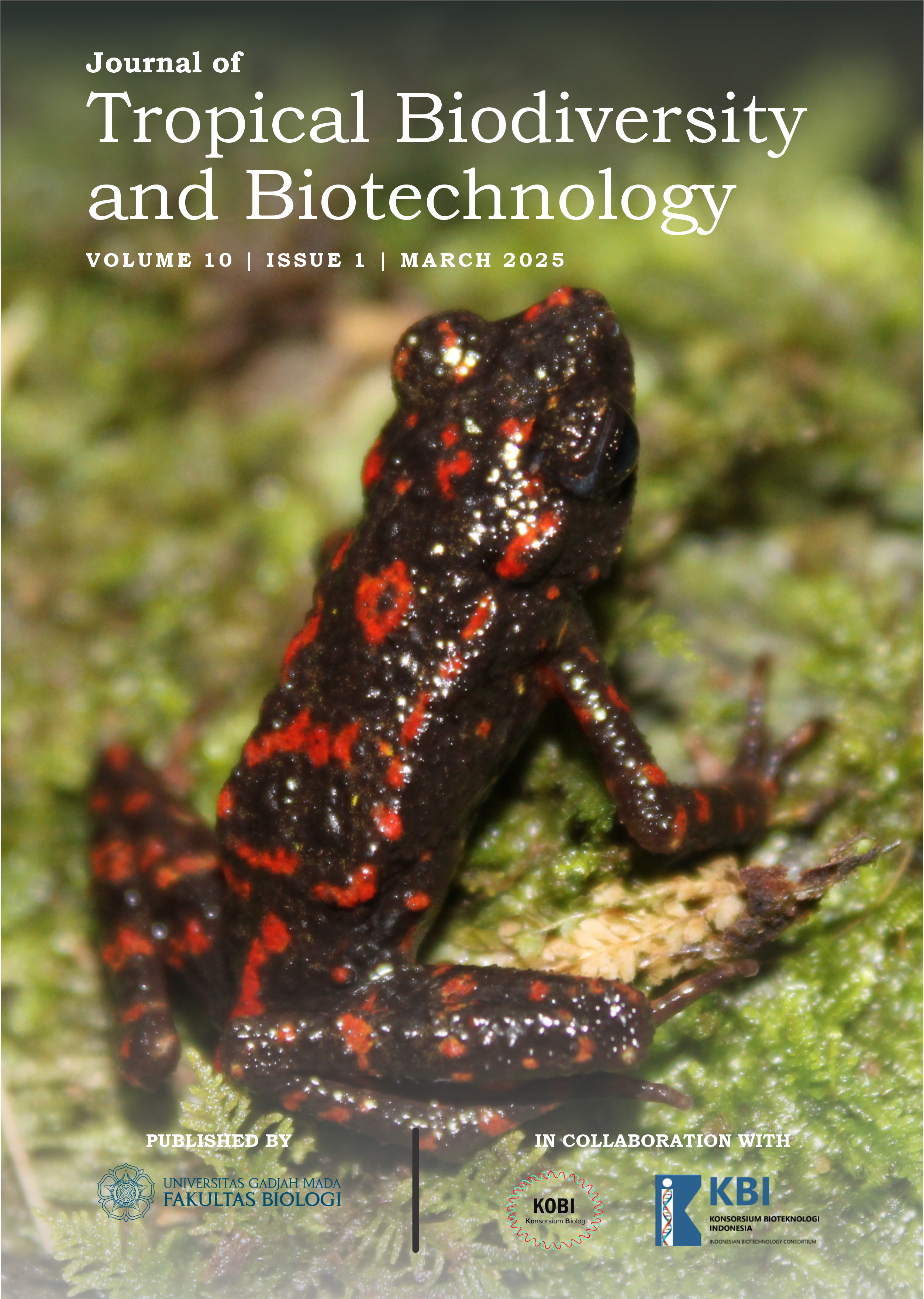Biodiversity and Ecosystem Services Analysis to Develop a University Botanical Garden: A Case Study in the University of Palangka Raya, Central Kalimantan
Abstract
Information on existing site characteristics both biotic and abiotic factors is mandatory to provide an initial picture for a baseline to develop a botanical garden. This study aimed to analyse the biodiversity and ecosystem services in the candidate botanical garden area as an existing site, a case study in the University of Palangka Raya (UPR) to prepare the university botanical garden development. The fieldwork was conducted in 5 transects consisting of 100 plots with a plot size of 20x20 m2. The results showed that the site is categorized as a Sundaland peat swamp forest ecoregion. The peatlands thickness varies from shallow to medium and deep, with the remaining area reaching 75 % of the total campus. The floristic condition is categorized as an early stage of succession after fires, consisting of 26 plant species belonging to 25 genera and 18 families, with various potential uses. Wildlife comprised 42 species including amphibians, reptiles, birds, fishes and prawns, also insects. Three high conservation value plants and two wildlife were documented. The stand carbon storage reached 14.33 tons/ha. A botanical garden consists of both natural and artificial ecosystems, thus it is important to strategically plan in setting the plant collections layout and species enrichment efforts. The UPR botanical garden will provide the conservation of native and endemic plants of Kalimantan, with high conservation value, potentials, and local wisdom value; and provide ecosystem services for storing carbon, improving hydrological services, habitat and protection for various existing and incoming wildlife.
References
Brockerhoff, E.G. et al., 2017. Forest biodiversity, ecosystem functioning and the provision of ecosystem services. Biodivers Conserv., 26, pp.3005–3035. doi: 10.1007/s10531-017-1453-2
Chave, J. et al., 2005. Tree allometry and improved estimation of carbon stocks and balance in tropical forests. Ecosyt Ecol., 145, pp.87–99. doi: 10.1007/s00442-005-0100-x
Davies, S.J. & Semuit, H., 2006. Competitive dominance in a secondary successional rain-forest community in Borneo. J Trop Ecol., 22(1), pp.53–64. doi: 10.1017/S0266467405002944
Dharmawan, I.W.S. et al., 2013. Allometric equation and vegetation carbon stock at primary and burnt peat forest. Jurnal Penelitian Hutan dan Konservasi Alam, 10(2), pp.175–191.
Doan, T.M., 2003. Which methods are most effective for surveying rain forest herpetofauna? J Herpetol., 37(1), pp.72–81. doi: 10.1670/0022-1511(2003)037
Gonggoli, A.D. et al., 2021. Identifikasi jenis kupu-kupu (Lepidoptera) Di Universitas Palangka Raya. Bioeksperimen, 7(1), pp.16–20.
Graham, L., 2009. A Literature review of the ecology and silviculture of tropical peat swamp forest tree species found naturally occurring in Central Kalimantan. The Kalimantan Forests and Climate Partnership. Australia Indonesia Partnership. doi: 10.13140/RG.2.1.2120.4882
Hapsari, L., Trimanto, T. & Budiharta, S., 2020. Spontaneous plant recolonization on reclaimed post-coal mining sites in East Kalimantan, Indonesia: Native versus alien and succession progress. Biodiversitas, 21(5), pp.2003–2018. doi: 10.13057/biodiv/d210527
Harenda, K.M. et al., 2018. The role of peatlands and their carbon storage function in the context of climate change. In Interdisciplinary Approaches for Sustainable Development Goals. GeoPlanet: Earth and Planetary Sciences. Springer, Cham. doi: 10.1007/978-3-319-71788-3_12
Indriyanto, 2010. Ekologi Hutan. Cetakan ke-3. Jakarta: PT Bumi Aksara.
Jaya, A. et al., 2007. Biomass content of tropical peat swamp forest under various land cover conditions. Jurnal Penelitian Hutan dan Konservasi Alam, 4(4), pp.341-352.
Kalima, T. & Denny, 2019. Species composition and peat swamp forest structure in Sebangau National Park, Central Kalimantan. Jurnal Penelitian Hutan dan Konservasi Alam, 16(1), pp.51–72. doi: 10.20886/jphka.2019.16.1.51-72
Karni, F., Naemah, D. & Bakri, S., 2021. Identification of ramin (Gonystylus bancanus) damage in Punggualas Sebangau National Park Central Kalimantan. Jurnal Sylva Scienteae, 4(3), pp.561–569.
Maulidi, A. et al., 2020. Short Communication: Herpetofauna diversity at the University of Palangka Raya, Indonesia. Biodiversitas, 21(10), pp.4509–4514. doi: 10.13057/biodiv/d211006
Maulina, A. et al., 2020. Short communication: The invasive of freshwater prawn Macrobrachium lanchesteri (De Man, 1911) from watershed in Palangkaraya University, Kalimantan, Indonesia. Natural Science, 9(2), pp.49–53. doi: 10.22487/25411969.2019.v9.i2.15183
Mirmanto, E., 2010. Vegetation analyses of Sebangau peat swamp forest, Central Kalimantan. Biochimie, 11(2), pp.82–88. doi: 10.13057/biodiv/d110206
Olson, D.M. & Dinerstein, E., 2002. The Global 200 : Priority Ecoregions for Global Conservation. Annal Missouri Bot Gard., 89(2), pp.199–224. doi: 10.2307/3298564
Posa, M.R.C., Wijedasa, L.S. & Corlett, R.T., 2011. Biodiversity and conservation of tropical peat swamp forests. BioScience, 61(1), pp.49–57. doi: 10.1525/bio.2011.61.1.10
Purnomo, D.W. et al., 2015. Developing plant collections on the regional botanic gardens in framework. Buletin Kebun Raya, 18(2), pp.111–124.
Purnomo, D.W. et al., 2020. Rencana 10 tahun (2020–2030) pengembangan kebun raya di Indonesia. Warta Kebun Raya, 18(2), pp.1–16.
Simbolon, H., 2008. Local distribution and coexistence of prevalent tree species in peat swamp forests of Central Kalimantan. Reinwardtia, 12(5), pp.373–382.
Siregar, M. et al., 2020. Vegetation and ecoregion analysis at Sipirok Botanic Gardens, South Tapanuli, North Sumatra, Indonesia. Biodiversitas, 21(6), pp.2526–2535. doi: 10.13057/biodiv/d210626
Trimanto, T., Hapsari, L. & Budiharta, S., 2021. Integrating indicators of natural regeneration, enrichment planting, above-ground carbonstock, micro-climate and soil to asses vegetation succession in postmining reclamation in tropical forest. Turk J Bot, 45(5), pp.457–467. doi: 10.3906/bot-2103-35
UNESCO., 1997, 'World Heritage Committee Inscribes 46 New Sites on World Heritage List, 1–7', in UNESCO: World Heritage Convention, viewed 1 February 2023, from https://whc.unesco.org/en/news/180/
UNESCO., 2024, 'Botanical Garden (Orto Botanico), Padua', in UNESCO: World Heritage Convention, viewed 23 September 2024, from https://whc.unesco.org/en/list/824/
UPR., 2018. Masterplan: Development concept University of Palangka Raya 2018-2034. University of Palangka Raya. Palangka Raya, Central Kalimantan.
Usmadi, D. et al., 2018. Diversity and conservation status of plants in the in situ forest of Tanjung Puri Tabalong, Pros Sem Nas Masy Biodiv Indon., 4(2), pp.304–309. doi: 10.13057/psnmbi/m040236
Witono, J.R. et al., 2020. Autecology of Drosera burmanni in the Wolobobo Botanic Gardens, Ngada District, Flores Island, Indonesia. Biodiversitas, 21(5), pp.2137–2145. doi: 10.13057/biodiv/d210542
Yulianti, N. et al., 2020. Preliminary analysis of cause-effect on forest- peatland fires prior to 2020 in Central Kalimantan. Ecotrophic, 14(1), pp.62–73.




